CHAPTER 1:
The struggle for a place in school
Refugee and local children attend a summer school in Vienna, Austria, run by three Syrian refugee volunteers. ©UNHCR/Stefanie J. Steindl
Education is not a luxury. It is a right.
As the world’s refugee situations multiply and in many cases worsen, it is becoming more and more challenging to ensure that new generations of displaced children get the education they deserve.
By the end of 2017, there were more than 25.4 million refugees around the world, 19.9 million of them under UNHCR’s mandate. More than half of the global refugee population – 52 per cent – were under the age of 18.
Of all the latest data, one statistic stands out: today, there are 4 million refugee children who are out of school. That is over half of the 7.4 million refugee children of school-age under UNHCR’s mandate.
In 2017, one million additional refugee children needed to go to school. Thanks to the major efforts of those committed to the New York Declaration for Refugees and Migrants, half of them were enrolled but the other half remain out of school.
In just one year, the number of refugee children out of school has increased by half a million.
Time in exile can last for years, if not decades, and some children have only known life as a refugee. This is why the long-term wellbeing of children and education are so important.
Millions of refugee children and youth will spend their entire childhood in a country that is not their own. They will spend their formative years deprived of the school environment which so many of us take for granted.
Mohammad, 7, Syrian refugee, was born as the Syrian conflict began and escaped with his family to Lebanon following a devastating attack on their home in Palmyra. Today he attends the Father Andeweg Institute for the Deaf (FAID) on the outskirts of Beirut, Lebanon. Photo ©UNHCR/Diego Ibarra Sánchez
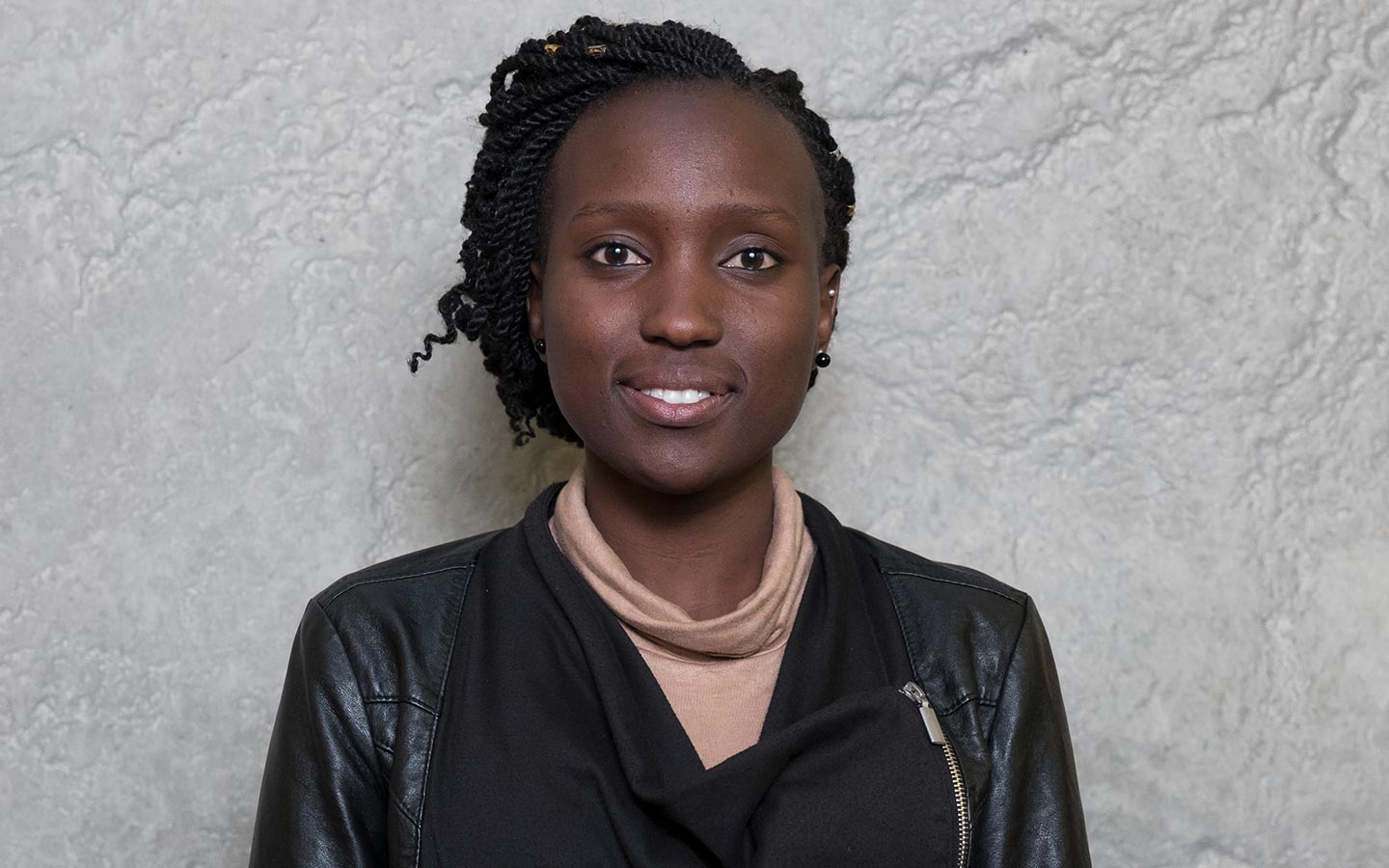
©UNHCR/Jean-Marc Ferré
“Children caught up in conflicts will end up either as peacemakers or as peacebreakers. The difference is the opportunities they get in exile.”
Foni Joyce Vuni, 25, South Sudan, is a DAFI graduate. DAFI – the Albert Einstein German Academic Refugee Initiative – is a scholarship programme for refugees implemented by UNHCR, the Government of Germany and others. Foni was among a dozen youth delegates who brought their experience of conflict and displacement to a high-level meeting in Geneva devoted to establishing a new global response to record levels of displacement.
The global picture
Comparing the situation of refugee children and youth with their peers illustrates the gap between the two – and the manner in which that gap grows to a chasm as they get older.
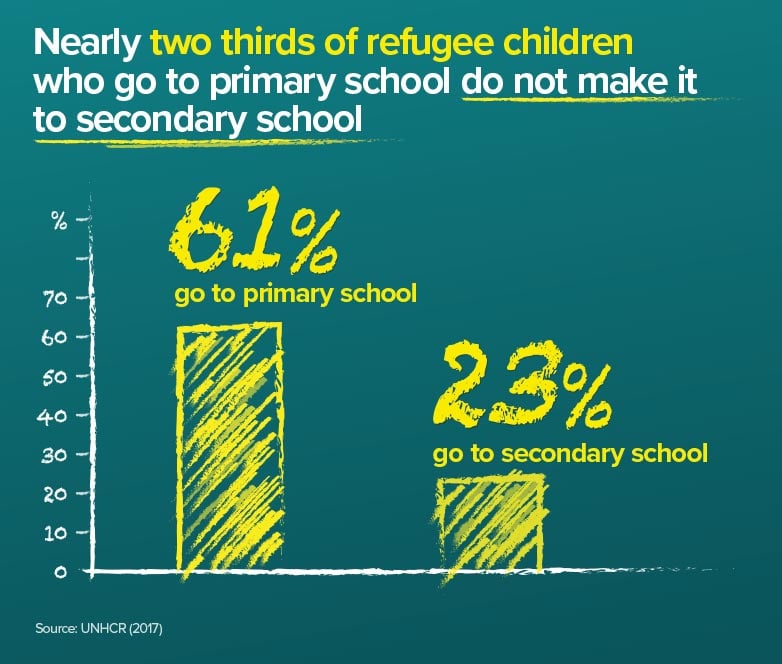
In 2017, 61 per cent of refugee children were enrolled in primary school, compared to 92 per cent globally. At secondary level the figure was 23 per cent, compared with a global rate of 84 per cent. This means nearly two thirds of refugee children who go to primary school do not make it to secondary school.
Even though in 2017 more than 500,000 refugee children were newly enrolled in school thanks to the far-reaching efforts of governments, UNHCR and partners, the rapidly growing refugee population means that, in percentage terms, the picture has not improved.
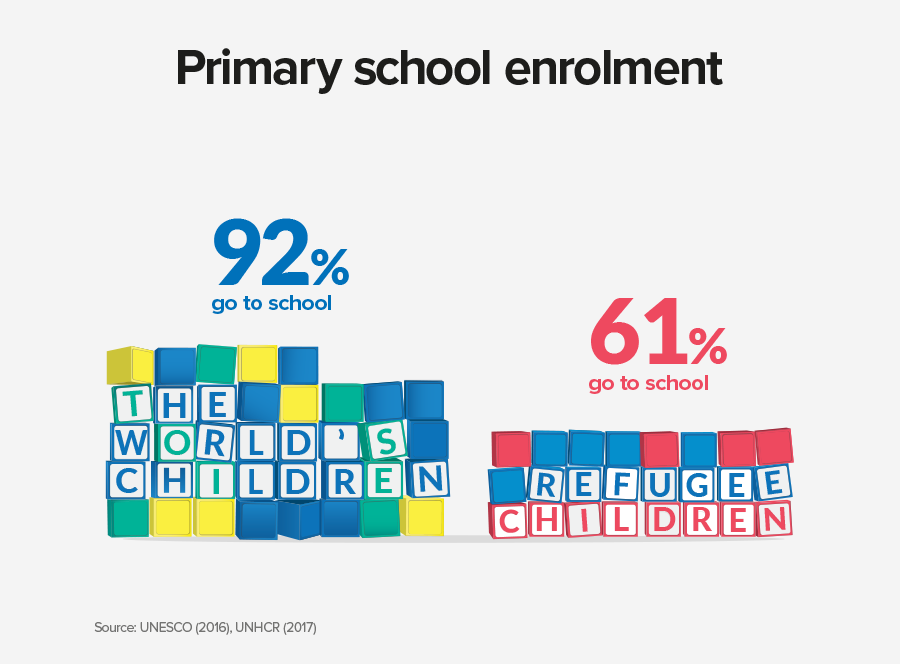

Taken as a whole, therefore, refugee children and youth have far fewer educational opportunities than their peers. Of the entire population of refugees, 54 per cent are out of school, compared to 10 per cent of children at primary or lower-secondary school level globally – meaning that at this level refugees are five times more likely to be out of school.
The statistics were markedly worse in low-income countries, which are disproportionately affected by refugee movements. Developing regions hosted 92 per cent of the world’s school-age refugees in 2017. In low-income countries, less than half of primary-age refugee children get to go to school. At secondary level, only 11 per cent have the same opportunity.
#HerTurn
Over the past three years we have also investigated the situation for refugee girls, who face even greater barriers to education. In a report published in March 2018, entitled “Her Turn”, we highlighted the social, health and economic benefits of ensuring that refugee girls have access to an education – yet in Kenya and Ethiopia, for instance, there are only seven girls for every ten boys enrolled in primary education, and four girls for every ten boys in secondary education.
If refugee girls can get an education, their families and communities are more likely to improve their social and economic position. UNESCO and World Bank research shows that educated mothers are more likely to send their children to school, especially their daughters, and are more likely to support them in attaining a secondary and higher education. The further girls progress with their schooling, the more they develop leadership skills, entrepreneurship and self-reliance – personal qualities that will help their communities to flourish as they strive to adapt to their host countries or as they rebuild their own homes.[1] [2]
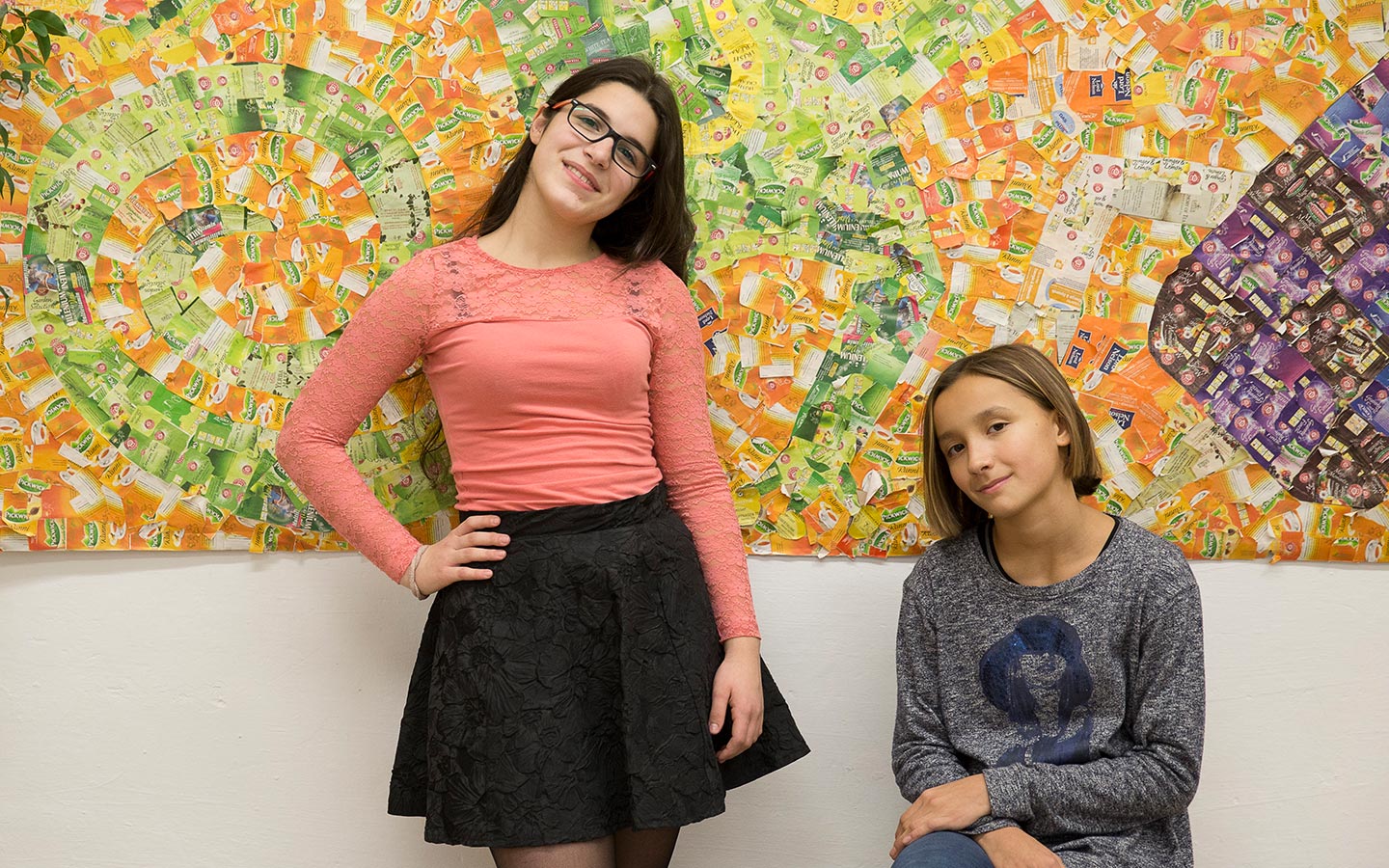
Natalia Rami Haddad, 14, Syrian refugee, with her Czech friend Natálie Sembdnerová, 12, at high school in Hradec Králové, Czech Republic. In 2017, Natalia received an award from the Czech Ministry of Education for her efforts as a language student. ©UNHCR/Michal Novotný
Furthermore, UNESCO research shows that one additional year of school can increase a woman’s earnings by up to a fifth.[3] Such benefits are felt by everyone; in countries where education is equal for both sexes, per capita income is boosted by 23 per cent.
If all women received a primary level education, child deaths from diarrhoea, malaria and pneumonia would fall, as innumerable studies show.[4] Deaths from diarrhoea, for example, the third-most frequent cause of child mortality, would be reduced by eight per cent if all mothers completed primary education, or by 30 per cent if they had secondary education.[5] These threats are especially acute in displacement situations.
Educated women are more likely to be aware of where to find professional help – some of it life-saving – when pregnant or as new mothers, while the further they progress with their schooling the more aware they are of the benefits of nutrition and sanitation.
At the age of four, Mary Maker and the surviving members of her family walked out of their home in war-ravaged South Sudan and sought sanctuary across the border in Kenya. A refugee for most of her life, Mary has fought tenaciously for the chance to go to school (she tells her remarkable story in her own words here). Her determination made her both a student and a teacher – a teacher whose classroom in Kakuma refugee camp sometimes had more than 120 children, and now a student again on a scholarship programme in Rwanda, preparing to take exams for a place at a university in the US or Canada.
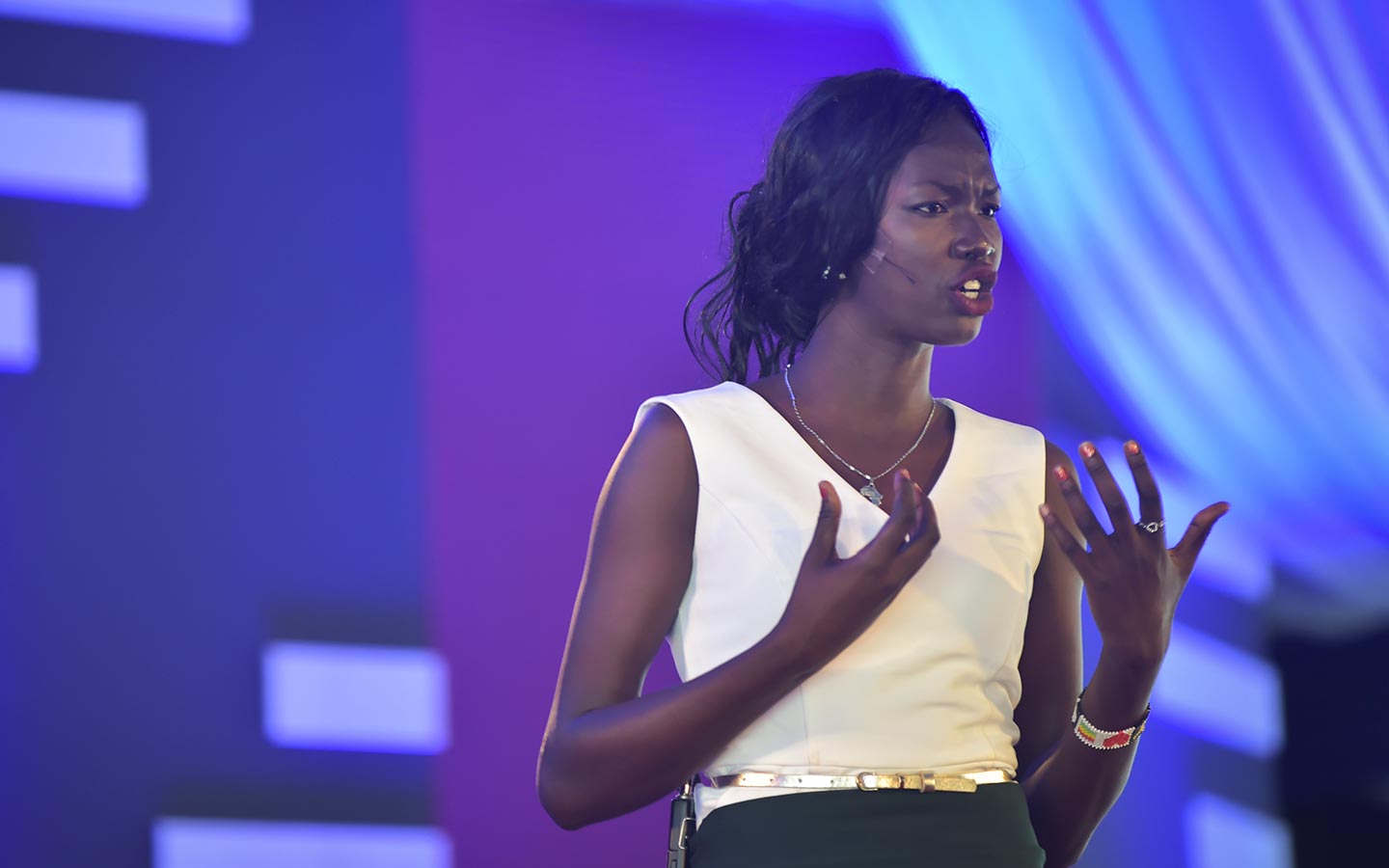
Mary Maker, South Sudanese refugee, speaks at TEDxKakumaCamp, held at a refugee camp in Kenya. ©TEDxKakumacamp/Tobin Jones
“With an education, everyone has an equal and fair chance to make it in life,” Mary says. “But I believe education is not only about the syllabus. It is about friendship and also a place to discover our talents and allow us to discover our destiny.”
CASE STUDY
Exposed to the elements
Even the basics are scarce in open-air classrooms in Nduta refugee camp, in northwestern Tanzania
Burundian refugee schoolchildren study outside under trees at Furaha Primary School in Nduta camp, Tanzania. At Furaha there are few classrooms and not enough desks. ©UNHCR/Georgina Goodwin
Irahoze Diello is quietly confident about his mathematics test. Even without books, shoes, a safe place to study or a morning meal, he has worked hard to prepare for this moment.
He just hopes the rain will hold off long enough for him to complete it.
“When it rains everything gets wet,” says Irahoze, 14, who fled Burundi and now studies beneath the trees in Nduta refugee camp, in northwestern Tanzania. “When it’s windy the branches fall, and when the sun is strong it’s too hot. Sometimes we have to stop classes.”
Irahoze is one of about 200 refugee children who study at Furaha Primary School, where classes are held in the open air. “When it’s windy our papers fly away and when it’s raining my books are ruined,” echoes Tuyishemele Kenilde, 15, from Burundi, who has already been held back a year.
Basic educational facilities are scarce in Nduta, Mtendeli and Nyarugusu, Tanzania’s three largest refugee camps. More than 70 per cent of students have to study outdoors, with just 193 permanent classrooms for almost 10,000 children. A high student-teacher ratio also adds to the difficulties.
There are nine primary schools in Nduta, but it’s not enough; a quarter of children aged between 6 and 14 do not attend school. And with only one secondary school, the enrolment rate at the secondary school is just eight per cent.
The enrolment rate at primary level in Nyarugusu camp is slightly higher, at 80 per cent, but several schools lack permanent buildings. Many children study in flimsy tents that collapse in the wind and bake in the midday sun. The classrooms that do have walls are hopelessly overcrowded, with as many as 120 pupils packed in.
Tanzania: Studying under the trees. Photo ©UNHCR/Georgina Goodwin
“We have quite a few classes with no desks,” says Hafashimana Euphrasie, 14, whose prized workbook is tattered and torn. “We really need some more so we don’t have to sit on the floor.” There is also a serious shortage of school books and reference materials.
At the Furaha Primary School in Nduta camp, there is also a troubling gender gap, with just one girl for every three boys who attend school.
The head teacher there, Ndayisenga Aimable, says many children go to school on empty stomachs and are often too hungry to concentrate.
For many, especially teenage girls, the challenges are too great. Instead, dropping out of school to earn money to support their families is viewed as a more attractive option, especially since food is hard to come by, school journeys are long and exams are difficult to pass.
The camps need another 640 classrooms to accommodate not only those children but all the others who are not enrolled yet desperately want to go to school. But the money just isn’t there: by July 2018, the Regional Refugee Response Plan to assist Burundian refugees in Tanzania has received only 14 per cent of its funding target for the year
At Nyarugusu’s Hope Secondary School, Claude Nahilma, 19, is uncertain about his future. He has been studying there since arriving from Burundi two years ago, but does not know where he will end up.
“It is difficult when you complete your studies to get access to university,” he says. “I want to go home to continue my studies. This is a dead end.”
CASE STUDY
Learning in the monsoon
Rohingya children brave wind and rain for just a couple of hours of school a day
Minara (left) and Jasmine, both aged 12, attend classes at Temporary Learning Centres in Kutupalong refugee settlement, Bangladesh. It is their first time going to school; back home both girls worked to help support their families. ©UNHCR/Caroline Gluck
As monsoon rains and strong winds batter southern Bangladesh, refugee families are doing their best to shield themselves from the worst of the weather. More than 720,000 Rohingya refugees are living here under bamboo and tarpaulin shelters, having fled Myanmar since August 2017.
Displacement always brings hardship. But for some children in Cox’s Bazar, it has also brought opportunity.
“Back home, I was busy with household chores,” says Minara, 12, from Myanmar’s Buthidaung township. “I had to work, so I never got the chance to go to school.”
At home, she often had to help her brothers look after the family’s 20 cows. Neither Minara nor any of her sisters went to school.
Refugees in Bangladesh do not have access to formal education, but at a Temporary Learning Centre in the vast Kutupalong refugee settlement, Minara is delighted to experience what school can be like. In a series of brightly decorated bamboo rooms, youngsters aged between 6 and 14 are intently taking part in a number of activities, from writing in workbooks to drawing, colouring and singing songs.
“I’ve learnt how to write here, and I can read as well,” Minara says. “I’m very happy to come here. We can learn, draw, sing and play with other friends.”
Her friend Jasmine feels the same about being in the temporary facility, which is run by a UNHCR partner, Community Development Centre. “Back home, my parents couldn’t afford to send me to school,” says Jasmine. Home is Maungdaw township in Myanmar’s Rakhine state, where she used to help her father at his small shop in the family house, selling fruit and vegetables. Many Rohingya children in Rakhine state have difficulty going to school because of restrictions on their freedom of movement and their families’ livelihoods.
“I’ve learnt to write the alphabet,” she says, smiling. “We can play and I’ve made lots of new friends.”
The two girls laugh as they say their dream is to become teachers so they can help others to learn.
Both this and other temporary learning centres run by UNHCR partners throughout the settlements are hoping to stay open during the monsoon season. This will not be easy: some of the buildings have been taken up by families whose accommodation was destroyed by landslides, while others have been flooded or otherwise damaged.
Class attendance is down because of the harsh weather. Indeed, Minara and Jasmine study in what is probably the wettest classroom in the world.
Nonetheless, alternative spaces have been found and teachers continue to hold classes six days a week. “We’re determined to keep the classes going,” says Community Development Centre project manager Jaidul Hoque. “Our centres are often safer places for children than the shelters where families are living. Although this is a very challenging time for us, we are trying our best.”
It is a bold and determined collective endeavour with plenty of enthusiastic pupils, but many challenges remain. Most of the centres focus on basic literacy and numeracy and life skills training, while most temporary learning facilities operate on double or even triple shifts, offering youngsters only a few hours of classes each day.
But for many, these sessions are seen as a lifeline by students and parents alike.
“Education is an important human right for these children and it is an important part of our protection activities as well,” says Mohammed Jahedul Islam Chowdhury, a UNHCR education associate in Cox’s Bazar. “Education can help empower the youngsters, who also learn how they can protect themselves. We are also asking parents to let their daughters come to learn. We are trying to get more girl students in class, so they can have more opportunities in the future.”
[1] UNESCO: Education Counts – Towards the Millennium Development Goals (2011)
[2] World Bank: Returns to Investment in Education: A Global Update (1993)
[3] UNESCO: Education Transforms Lives (2013)
[4] Gakidou, Cowling, Lozano and Murray. (2010). Increased Educational Attainment and Its Effect on Child Mortality in 175 Countries between 1970 and 2009: A Systematic Analysis. The Lancet, Volume 376 (No. 9745), pp. 959-974






